We have three TVs in my house, but only two of them are connected to cable boxes. I have the TV in my bedroom connected to a Roku 3 box (see related links for my review), so I can access the Time Warner Cable programming they make available through Roku’s TWC channel. Unfortunately, the TWC channel doesn’t include any of the local broadcast stations in that programming. I’ve tried various indoor antennas with that TV with various degrees of success. I was pleased to be selected to try out the FlatWave Amped HD Antenna when Winegard offered one to The Gadgeteer for review. This is the first amplified indoor wall antenna I’ve tried. I hooked it up to my Vizio HDTV and started trying it out immediately.
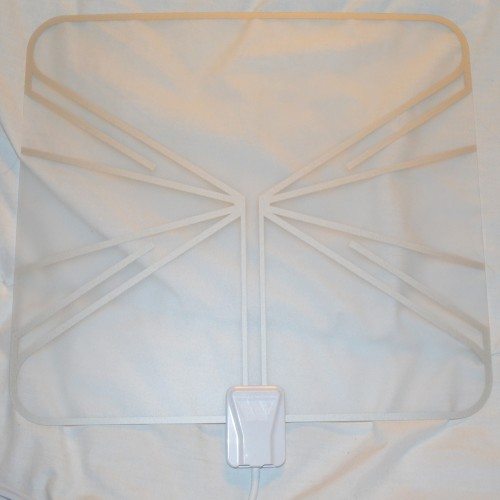 Some descriptions I’ve read say the antenna is white on one side and black on the other, but the antenna I received is made of frosted clear plastic. It measures about 13″ X 12″. You can see silver ribbons embedded in the plastic; they form the antenna. The white casing at the bottom is where the antenna is connected to the coaxial cable.
Some descriptions I’ve read say the antenna is white on one side and black on the other, but the antenna I received is made of frosted clear plastic. It measures about 13″ X 12″. You can see silver ribbons embedded in the plastic; they form the antenna. The white casing at the bottom is where the antenna is connected to the coaxial cable.
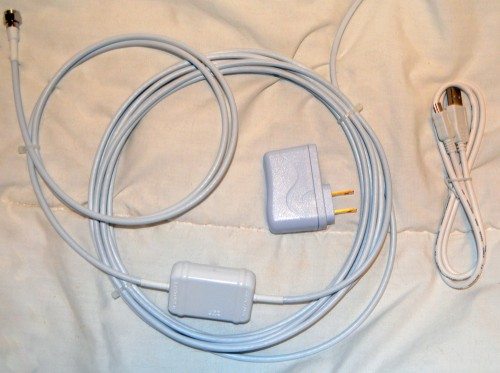 Here you see the rest of the 18.5′ mini coax cable. The white box located near the connector end is the powered amplifier. Winegard says this amplified antenna uses their “Revolutionary Clear Circuit Technology™, which provides ultra low noise figure – 1.0 dB”. One side of the amplifier box has a small green LED to indicate when it’s powered; the opposite side has a miniUSB port for connecting the supplied 3-ft miniUSB-to-USB power cable. If your TV has a powered USB port on the back, you can plug the USB power cable in there. If you don’t have one, you can use the included AC power adapter. My Vizio has a USB port on the back that is described as being a service port, so I wasn’t sure it would work for powering the antenna. It actually does provide power, which makes the relatively short USB power cable work. If I needed to use the wall adapter, the 3′ USB power cable wasn’t long enough to reach the wall outlet, and I would have needed a drop cord to plug the antenna in. Winegard says using the TV’s USB port means the antenna will draw power only when the TV is turned on, but that’s not the case with my Vizio TV. The green light indicates the amplifier is receiving power even when my TV is turned off. That’s a function of my Vizio TV, though, and not the FlatWave antenna’s amp.
Here you see the rest of the 18.5′ mini coax cable. The white box located near the connector end is the powered amplifier. Winegard says this amplified antenna uses their “Revolutionary Clear Circuit Technology™, which provides ultra low noise figure – 1.0 dB”. One side of the amplifier box has a small green LED to indicate when it’s powered; the opposite side has a miniUSB port for connecting the supplied 3-ft miniUSB-to-USB power cable. If your TV has a powered USB port on the back, you can plug the USB power cable in there. If you don’t have one, you can use the included AC power adapter. My Vizio has a USB port on the back that is described as being a service port, so I wasn’t sure it would work for powering the antenna. It actually does provide power, which makes the relatively short USB power cable work. If I needed to use the wall adapter, the 3′ USB power cable wasn’t long enough to reach the wall outlet, and I would have needed a drop cord to plug the antenna in. Winegard says using the TV’s USB port means the antenna will draw power only when the TV is turned on, but that’s not the case with my Vizio TV. The green light indicates the amplifier is receiving power even when my TV is turned off. That’s a function of my Vizio TV, though, and not the FlatWave antenna’s amp.
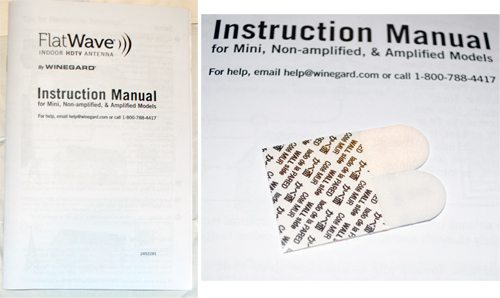 The box also includes an instruction manual and two 3M Command adhesive strips to attach the antenna to the wall.
The box also includes an instruction manual and two 3M Command adhesive strips to attach the antenna to the wall.
The instructions say that you can place the antenna on a wall or window or even lay it flat on a table top. If you have it on a wall or window, you should place it as high as possible for best reception. They also suggest you try the antenna at several locations to find the best reception. Once you have determined the best location for your antenna, use the Command adhesive strips to attach it to the wall. Using the Command strips means you’ll be able to remove the antenna later without damage to the paint or the walls.
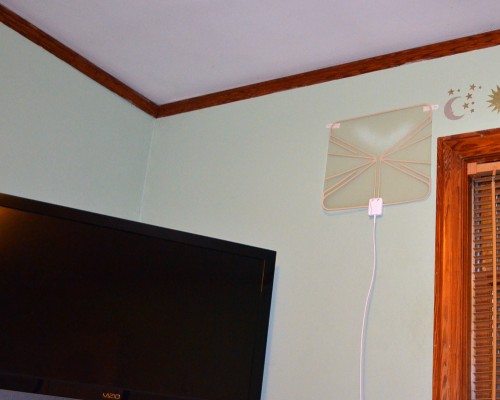 This location near my window provided the best reception in my bedroom. I don’t think the actual antenna looks that bad on the wall, but the big metal connector, the white Command strips, and the coax cable dangling down my wall don’t look so pretty. I found myself wishing they had included clear Command strips, but that still wouldn’t have done anything about the metal connector and the cable. Info on the Winegard site says you can’t paint the antenna itself, but perhaps I could paint the box and cable without interfering with signal reception.
This location near my window provided the best reception in my bedroom. I don’t think the actual antenna looks that bad on the wall, but the big metal connector, the white Command strips, and the coax cable dangling down my wall don’t look so pretty. I found myself wishing they had included clear Command strips, but that still wouldn’t have done anything about the metal connector and the cable. Info on the Winegard site says you can’t paint the antenna itself, but perhaps I could paint the box and cable without interfering with signal reception.
Each location that you check out for signal reception strength requires you to have your TV do a channel scan. The antenna is described as omni-directional, but some orientations will work better than others.
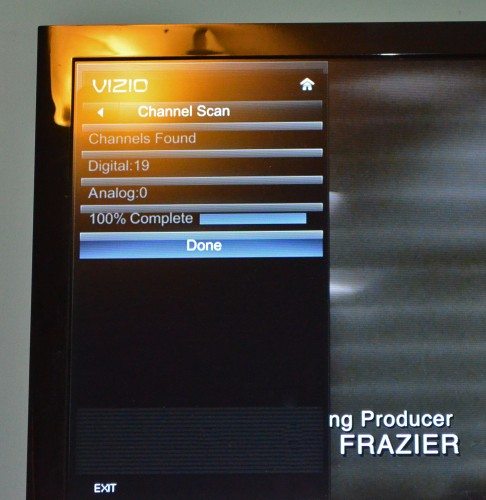 I did a final channel scan once I had permanently installed the antenna in the location near my window. You can see from the scan result that 19 digital stations were found; no analog stations were located.
I did a final channel scan once I had permanently installed the antenna in the location near my window. You can see from the scan result that 19 digital stations were found; no analog stations were located.
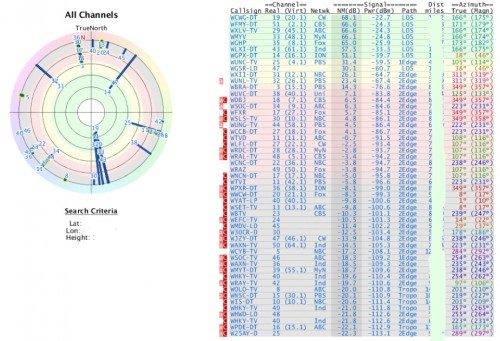 I used the TV Fool website to find out what stations were in my area and which ones I should be able to receive. (TV Fool offers various tools associated with free, over-the-air TV signals. They don’t seem to sell or recommend any particular antennas, but they do have ads for antennas and TV services.) Click on the above image to see the report for my location. I obscured the exact coordinates for my location and the distances to the various antennas. The stations in the green region are located less than 30 miles from my location and should be available to me with an indoor antenna. The yellow region indicates channels that will require an amplified signal or an attic antenna; channels in the red regions will require an outdoor aerial antenna for reception; and the channels in the gray region won’t be available to me without extreme measures, if at all.
I used the TV Fool website to find out what stations were in my area and which ones I should be able to receive. (TV Fool offers various tools associated with free, over-the-air TV signals. They don’t seem to sell or recommend any particular antennas, but they do have ads for antennas and TV services.) Click on the above image to see the report for my location. I obscured the exact coordinates for my location and the distances to the various antennas. The stations in the green region are located less than 30 miles from my location and should be available to me with an indoor antenna. The yellow region indicates channels that will require an amplified signal or an attic antenna; channels in the red regions will require an outdoor aerial antenna for reception; and the channels in the gray region won’t be available to me without extreme measures, if at all.
I was only able to receive stations in the green region, and I receive all of them. Although the FlatWave Amped specs indicate I should be able to receive stations 50 miles away, the scan didn’t find any of the channels in the yellow region. All the channels I did receive are located SSE of my house. I couldn’t receive the local NBC station nor the PBS stations, whose towers are all located north of me. Funnily enough, I got the best reception with the antenna placed on the wall that faces almost perfectly east.
In addition to the main channel (the “-1″ channel) for each station, I also could receive the extra 1, 2, or 3 stations they simultaneously transmit. All the stations I get have very sharp, clear pictures. My bedroom TV is only 720p, and the signals I receive are 1080, so reception may be even better on a full HD set. The pictures look as sharp and clear as I’ve ever gotten with any antenna, and they look as good as the HD channels I can watch through the Roku 3 and its TWC programming. Reception is smooth, without pixelation or dropouts most of the time. There were a couple of days when storm systems were in the area when I did get some minor freezing up for a second or two at a time, but those problems disappeared as the storm systems moved out of the area.
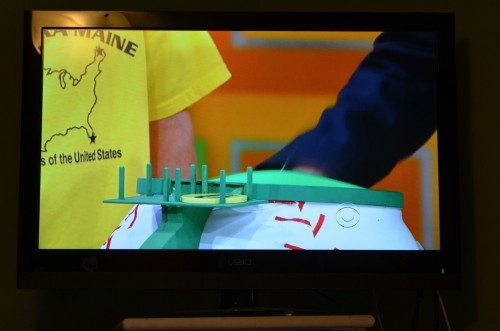 Here’s a photograph taken of some programming on CBS. It was daylight, and the photo was taken from across the room with no flash. My ceiling light was on, and that’s the source of the glare you see at the upper left of the image.
Here’s a photograph taken of some programming on CBS. It was daylight, and the photo was taken from across the room with no flash. My ceiling light was on, and that’s the source of the glare you see at the upper left of the image.
I think the FlatWave Amped antenna does a good job. It doesn’t pull in channels from 50 miles away for me, but that may have to do with the fact that most of the stations in my area are mostly almost 180-degrees opposite the NBC and PBS stations. I do like that the orientation I’ve chosen gives me most of the channels available to me as clear, clean, and strong as I’ve ever gotten. I never watch NBC anyway, so I’m happy that it’s the one I can’t get.
The FlatWave Amped started out at about $90, but Winegard has dropped the price to about $60 now. That’s not chump change, but it’s much cheaper than the approximately $13 a month to rent a cable box and remote every month. It will pay for itself in about half a year, and then my network TV is free – just like in the olden days of my youth. ;)
Product Information
| Price: | $59.99 |
| Manufacturer: | Winegard |
| Requirements: |
|
| Pros: |
|
| Cons: |
|
Filed in categories: Audio, Video, TV Gear, Reviews
Tagged: Antenna, Digital TV
Winegard FlatWave Amped indoor antenna review originally appeared on The Gadgeteer on June 26, 2013 at 11:00 am.
Source: http://the-gadgeteer.com/2013/06/26/winegard-flatwave-amped-indoor-antenna-review/
INTUIT INTERSECTIONS INTERNATIONAL RECTIFIER INTERNATIONAL GAME TECHNOLOGY
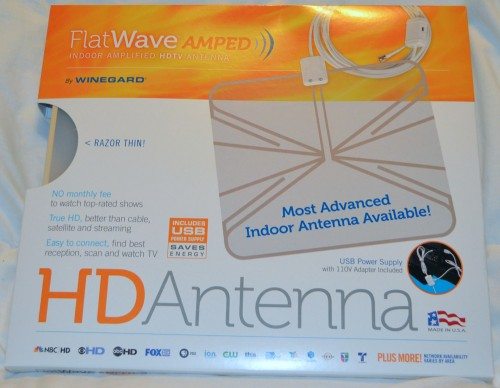
No comments:
Post a Comment